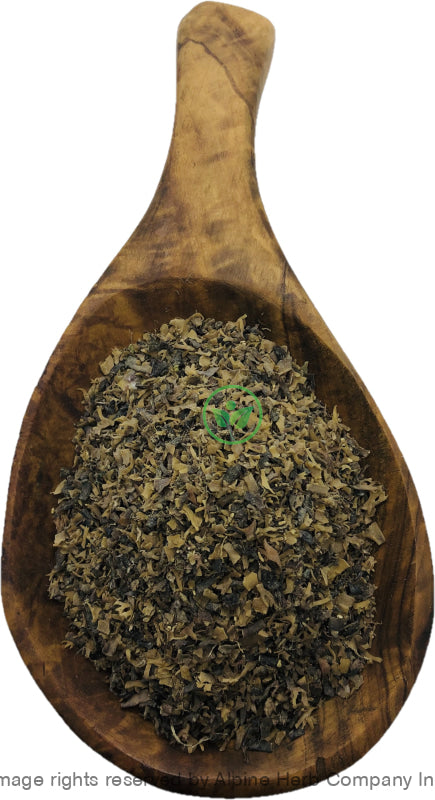Irish Moss Cut Alpine Herb Company Inc.
$ 16,99 $ 10,19
Botanical Name: Chondrus crispus
Common Name:
- English: Irish Moss
- Also, known as: Carragheen, Carraigin, Carrageen, Carrageen Moss, Mousse d’Irlande , Irisch Moos, Musgo perlado, Irlandisches Moss, Jelly Moss, Felsenmoss, Gelatitang, Knorpeltang, Perlmoss, and Dorset Weed.
Habitat: North Atlantic at low tide shores
Origin: Canada
Harvested: Cultivated
Parts Used: Entire plant (Thallus).
General Information:
Chondrus crispus, also called carrageen, species of red algae are seaweed-like kelp or dulse, are good herbal foods. Irish moss occurs both in the lower intertidal and shallow subtidal stages, in 5-25 m depending on wave action, water transparency and local topographic conditions is a tufted seaweed with thin branching fan-like fronds from 5-20 cm long. The alga is cartilaginous, varying in color from a greenish-yellow to a dark purple; when sun-dried and bleached. Color of fronds varying with the period of the year and depth, from white to yellowish-green in summer and in shallow water and dark purplish-red in autumn and in deeper water, frequently iridescent underwater.
Irish Moss has been used in Ireland since the beginning of the 19th century as a folk remedy for respiratory ailments. They are effective both internally and externally for soothing dry and inflamed surfaces or membranes. Used as food for domestic animals like sheep and horses in Iceland and also in Norway, Scotland, and Ireland. The alga is also boiled with milk and sugar or honey and served as a drink in many places. Its use was exported to New England in the USA in the mid-19th century.
Also found on rocks and stones and in tide pools. It is widely distributed and abundant, forming a thick carpet over rocks and ledges. Irish Moss is harvested as Carragheen to be used in the food, pharmaceutical, and cosmetic industries. It is a source of carrageenan used to make soups, jellies, etc. and as a thickening agent for sweets. Ireland was also used as a traditional remedy for respiratory disorders. The Irish-moss industry is the oldest seaweed industry in the U.S.A., since 1940.
How to use:
Hot Infusion:
The basic method for dried herbs and flower is, take 2-3 tablespoons of dried herb in a cup or teapot. Pour hot water over it and cover it with lid for 10-30 minutes. Hot water is needed to draw out the antioxidants, enzymes, vitamins, flavonoids, and volatile oils from the botanicals. Strain and squeeze out as much as liquid as possible and enjoy!
Tips:
- You can sweeten your herbal tea with a bit of honey, natural fruit juice, stevia leaves powder and or licorice root powder.
- You can make ice cubes or pops by freezing tea in ice trays or pop molds.
Precautions:
You should consult with a qualified healthcare practitioner before using any herbal products, particularly if you are pregnant, nursing, or on any medications.
All information on this website is for educational purposes ONLY.
This information has not been evaluated by Health Canada.
This information is not intended to diagnose, treat, cure, or prevent any disease.
| Unit Size | 100g, 200g, 400g, 1kg |
|---|
Prompt shipping and expert packing
Thanks to our longstanding association with UPS FedEx DHL as well as other leading global carriers, we can offer a variety shipping options. Our warehouse staff is highly trained and will be able to pack your goods in accordance with our precise and exact specifications. Your items will go through an exhaustive examination before they will be securely packaged before being delivered. We ship to hundreds of thousands of customers daily in different countries. This is a sign of our determination to become the largest online retailer worldwide. Warehouses and distribution centers are located throughout Europe as well as in the USA.
Note that orders containing multiple items are processed according to the particular item.
We will thoroughly inspect all items ordered before shipping. Most orders are shipped within 48 hours. The delivery time will be between 3 and 7 working days.
Returns
The stock market is always changing. It's not entirely managed by us since we're involved with several entities, including the factory and the storage. Therefore, the actual inventory could fluctuate at any moment. Please be aware that it is possible that your order could be out of stock after you've placed your order.
Our policy lasts for 30 days. If it's been more than 30 days since the date you purchased your item We're sorry to say that we can't offer you a full exchange or refund.
You can only return a product if it is unused and still in the same state as when you received it. The item should be in the original packaging.


































